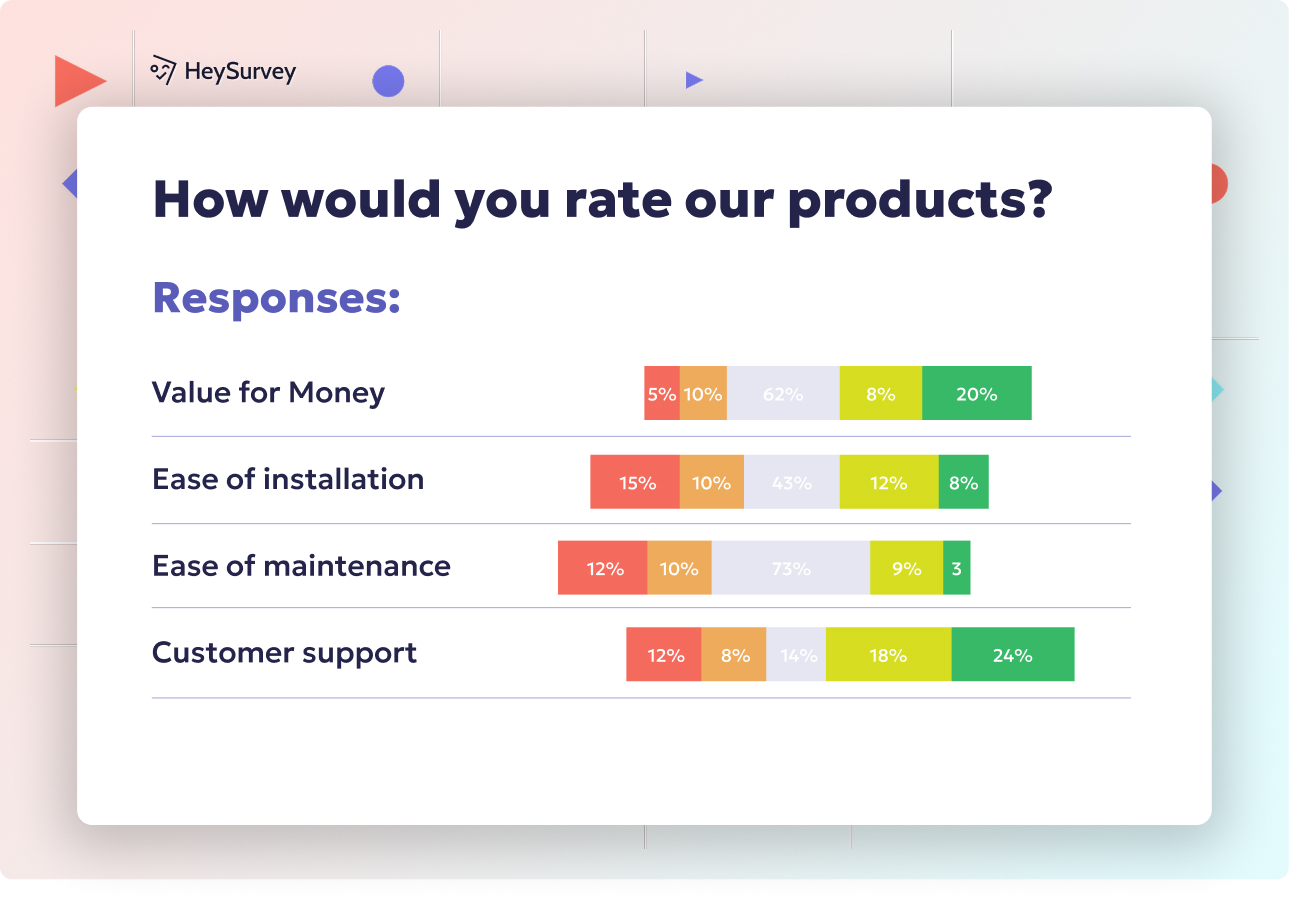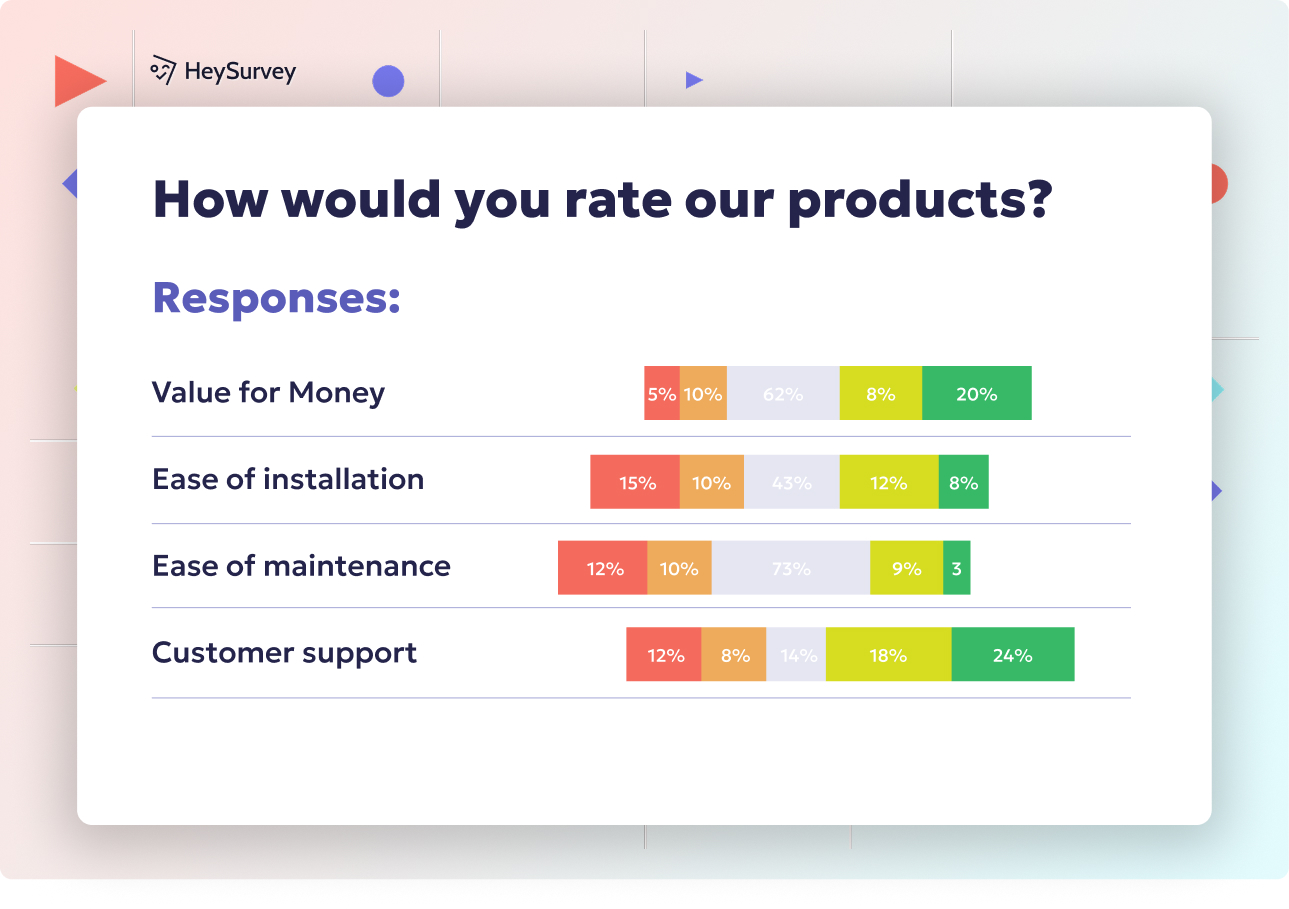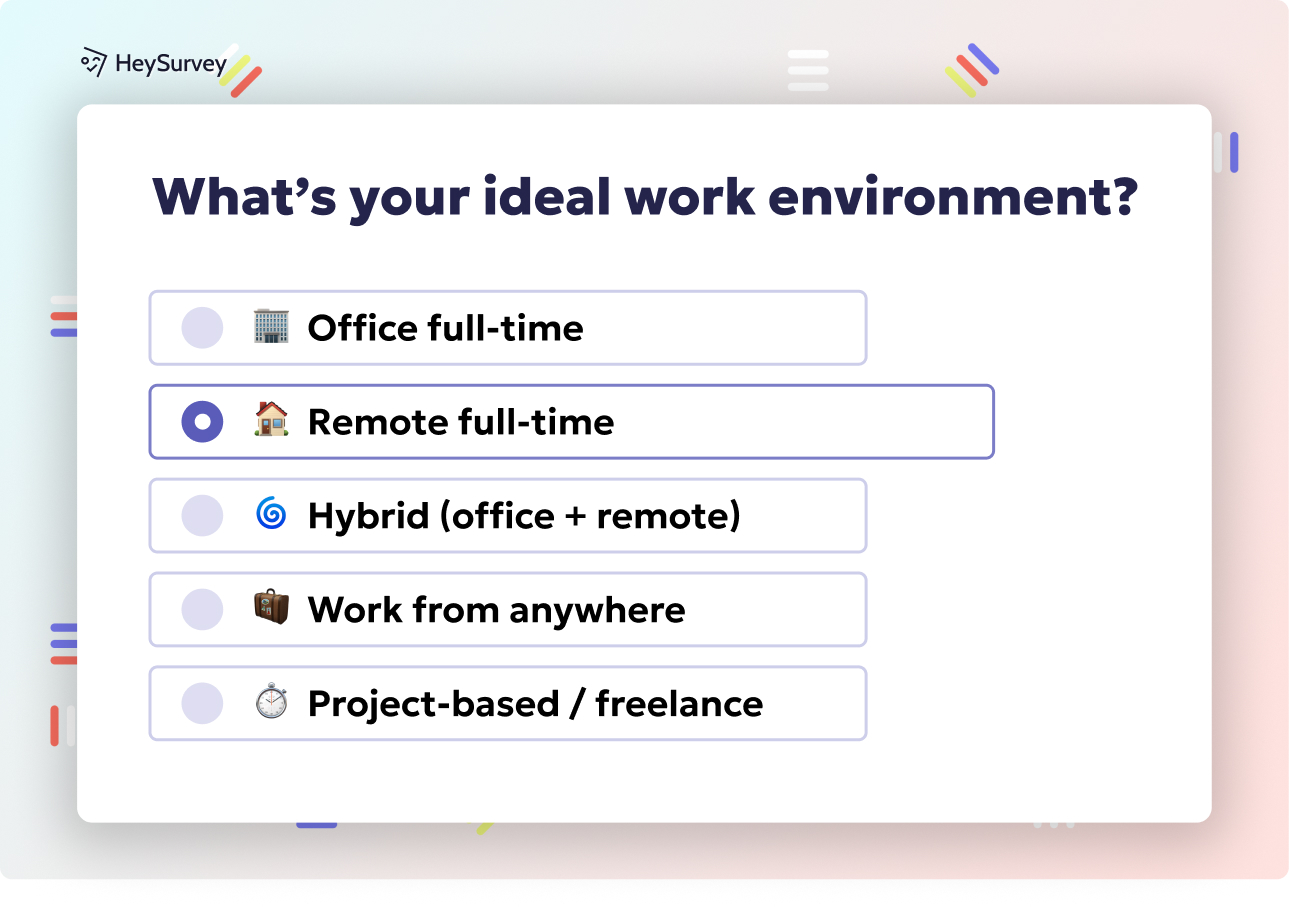29 Essential SWOT Survey Questions for Strategic Insights
Discover 25+ expert SWOT survey questions designed to capture strengths, weaknesses, opportunities, and threats for actionable insights.
Every organization thinks it knows its strengths and weaknesses, but too often, hidden gems and costly blind spots lurk below the surface. Enter the trusty SWOT analysis—Strengths, Weaknesses, Opportunities, and Threats—an age-old tool for dissecting challenges and charting strategic paths. While classic SWOT workshops can be enlightening, their reach is often limited by groupthink or time. Injecting the power of SWOT-focused survey questions turbocharges this process by capturing broad, unbiased insights from diverse voices. These surveys shine brightest during annual planning, launches, mergers, or even workplace culture deep-dives—practically any moment where quick, actionable intel can mean the difference between a brilliant move and a strategic stumble. Get ready to explore four targeted survey types, plus tips to keep questions sharp, results relevant, and analysis bias-free!
Strength Survey Questions
Why & When to Use This Survey Type
Sometimes organizations overlook what’s working well right under their noses. Uncovering internal strengths through well-crafted surveys lets teams double down on what already drives success. Whether it’s a legendary customer service process or a unique technical wizardry, surfacing tangible strengths cements your competitive edge.
- Ideal moments for these surveys include the start of strategic planning sessions
- When briefing new hires or rebranding as an employer of choice
- During reviews to validate that your perceived strengths match reality
Tapping into this knowledge amplifies morale—everyone gets to brag a little about what they do best. Recognizing strengths builds pride and alignment, which pays off in every customer interaction and boardroom discussion.
5 Sample Strength Questions
Which internal processes consistently exceed customer expectations?
What resources or skills give our team a clear advantage over competitors?
Which recent success should we replicate across other departments?
How would you describe our brand’s greatest strength in one sentence?
On a scale of 1-10, how effectively do we leverage technology to drive value?
By drawing responses from across your company, hidden pockets of excellence become visible, and these bright spots can be broadcast far and wide. That’s how ordinary teams start to act like industry leaders—by harnessing proven wins and inspiring others to follow suit.
Strength surveys are not a one-and-done exercise. Rotate them at every major milestone or pivot to track shifts in perception and ownership of key capabilities. The results? A reputation for resilience and a team bursting at the seams with pride.
Effective SWOT analyses involve asking targeted questions to identify organizational strengths, such as unique resources, competitive advantages, and areas of excellence. (streetwisejournal.com)

How to Create a SWOT Survey with HeySurvey in 3 Easy Steps
Ready to gather those juicy SWOT insights using HeySurvey but not sure where to start? No worries! Here’s a quick, no-fuss guide to get your SWOT survey off the ground.
Step 1: Create a New Survey
- Head over to HeySurvey and hit the Create Survey button.
- Choose to start with a pre-built template (there’s one tailored for SWOT surveys!) or start fresh from an empty survey if you want total control.
- Give your survey a catchy internal name so you can spot it easily later (something like “Q2 SWOT Pulse” works perfectly).
That’s it—you’re now officially surveying!
Step 2: Add Your SWOT Questions
- Click Add Question to start building your survey.
- Pick your question types: Likert scales for ratings, multiple choice for quick selections, or open text for insightful comments.
- Use the example SWOT questions found earlier in this guide (strength, weakness, opportunity, and threat) as your question bank.
- Make sure to mark crucial questions as required so nobody skips the good stuff.
- Pro tip: Add images or descriptions if a question needs extra context. It makes answering easier and more fun.
Step 3: Publish Your Survey
- Ready? Click Preview to see how your survey looks—test it out on desktop and mobile to make sure it’s smooth sailing.
- When everything’s sparkly and perfect, hit Publish.
- Share your survey link anywhere—email, chat, or embed it on your intranet.
Voilà! Your SWOT survey is live and ready to capture those actionable insights.
Bonus Steps to Level Up Your Survey
To really wow your audience and make data analysis a breeze, here are some extra moves:
Apply Branding
Upload your company logo in the Designer Sidebar to make the survey unmistakably yours. Customize colors and fonts to match your brand vibe for consistency and trust.Define Settings
Set a start/end date, add a response cap if you want, or create a redirect URL—like your company homepage or a thank-you message after completion. You can even toggle on whether participants may view summary results!Skip Logic and Branching
Use HeySurvey’s branching feature to tailor the flow based on answers. For example, if someone flags a serious threat, you can route them to follow-up questions just for risk assessment. This keeps the survey relevant and respects respondents’ time.
Now, if you’re pumped and want to jump in quickly, just click the “Start SWOT Survey Template” button below and watch HeySurvey do its magic—all the hard work is part of the template, and you just tweak away.
Happy surveying! Your business will thank you.
Weakness Survey Questions
Why & When to Use This Survey Type
If strengths are the gold nuggets, weaknesses are the pesky pebbles in your shoe. Rooting out weaknesses is a delicate business, but there’s no faster antidote for slow growth or frustration. Honest, well-timed surveys encourage people to flag the rough spots that hold everyone back.
Deploy these surveys:
- Before launching transformation or restructuring initiatives
- When tackling cost-reduction drives or customer satisfaction dips
- To diagnose the “why” behind recurring misses or workplace gripes
This proactive approach avoids blame games and turns feedback into fuel for improvement. It’s about collective, constructive honesty—not witch hunts!
5 Sample Weakness Questions
Which routine tasks consume the most time yet add the least value?
Where do you feel our product or service underperforms against competitors?
What key capability would most improve your day-to-day work?
Rate our communication flow across teams (1-10) and explain your rating.
What internal policy most frequently slows customer delivery?
Employing these questions uncovers bottlenecks, outdated workflows, and unnecessary bureaucracy. Every response is a breadcrumb trail leading to greater efficiency, productivity, and team cohesion.
Don’t treat survey answers as gripes. Instead, celebrate candid feedback and rally teams around fixing what’s broken. Being open about weaknesses signals a growth mindset—and nothing is more attractive to top talent or strategic partners than an organization always on the move.
Research indicates that poorly designed employee surveys can lead to misleading conclusions, making it difficult to drive meaningful change. Source
Opportunity Survey Questions
Why & When to Use This Survey Type
Opportunities often arrive disguised as challenges or clever customer suggestions. Harnessing them isn’t just luck—it’s about actively listening for new possibilities using strategic surveys. Tap into these questions to reveal hidden markets, unmet needs, or the next big thing.
Prime scenarios for opportunity surveys include:
- Right after comprehensive market research to validate findings
- During innovation roadmap planning or brainstorming new business models
- When growth hits a plateau and you need a fresh injection of ideas
Survey-generated opportunities are strategic goldmines waiting to be acted upon. Often, frontline employees and customers spot trends and gaps long before leadership does.
5 Sample Opportunity Questions
Which customer segments request features or services we don’t yet offer?
What industry trends could we capitalize on in the next 12-24 months?
If you had unlimited budget, which new product would you launch first?
Name one partnership that could instantly expand our reach.
How could we repurpose existing assets to enter a new market?
Responses will illuminate idea-rich terrain—maybe there’s a surprising crossover product, or perhaps one untapped alliance could open an entire new region. Rapid experimentation based on these findings transforms organizations from risk-averse to opportunity-hungry.
Don’t let ideas sit and gather dust. Follow up with focus groups, pilot projects, or dedicated innovation teams. You might just discover your next headline-grabbing success.
Threat Survey Questions
Why & When to Use This Survey Type
Spotting trouble before it hits is the ultimate superpower for any organization. Threat survey questions are radar detectors—scanning for competitive attacks, legal pitfalls, supply shocks, or disruptive tech. Used thoroughly, they give your team precious time to prepare or pivot.
Pull out these questions:
- During formal risk assessments or quarterly strategy reviews
- When the market feels like it’s shifting under your feet
- As part of crisis drills or scenario planning exercises
Proactive identification of threats keeps paranoia at bay—and builds a culture that’s cool under pressure, ready to roll with punches instead of frantically scrambling.
5 Sample Threat Questions
Which competitor’s actions pose the greatest risk in the next year?
What external factors could negatively impact our supply chain?
How vulnerable are we to rapid changes in customer preferences?
Identify any regulatory changes that could challenge our model.
Rate the likelihood of disruptive technologies eroding our market share (1-10).
Teams who regularly assess threats are never caught flat-footed. Responses paint a clear danger zone—allowing leaders to scenario-plan, shore up weak spots, and get creative with backup strategies.
Share findings widely (but sensitively). When everyone understands what’s at stake, you get a workforce united not by fear, but by resilience.
Regularly assessing threats through SWOT analysis enables organizations to proactively identify and mitigate potential risks, enhancing strategic planning and resilience. (indeed.com)
Mixed SWOT Pulse Surveys
Let’s face it: long surveys can be as fun as a trip to the dentist. That’s where mixed SWOT pulse surveys come in. These micro-surveys sample 1–2 sharp questions from each SWOT quadrant, delivering maximum insight with minimal fuss.
Here’s why they matter:
- Keep the organization’s finger on the strategic pulse, catching shifts early
- Provide continuous trend lines, so you see changes before they become problems
- Rotate respondent pools, ensuring fresh perspectives and reducing survey fatigue
Pulse surveys are an agility boost—speedy, repeatable, and great for tracking how strategy evolves. Instead of waiting for a yearly planning slog, leaders can sense changes quarterly or monthly, then tweak plans accordingly.
Cadence matters. Too often, and you risk fatigue; too seldom, and you miss the point! Monthly or quarterly rhythms strike the ideal balance, especially when you mix up who gets surveyed each round.
The magic is in smart design—mixing big-picture and granular questions, keeping it snappy (no more than 8 questions per pulse), and always closing the loop with transparent communication. Quick survey, quick analysis, quick action.
How to Analyze and Act on SWOT Survey Data
All the feedback in the world won’t help unless you know how to decode it. To extract real value, get surgical with your survey data.
Start by segmenting the responses:
- By department or function—what’s a strength in marketing may be a weakness in operations
- By geography—global teams often have wildly different perspectives
- By tenure—new hires spot issues forgotten by veterans, and vice versa
Use scoring methods:
- Likert averages for quantitative questions
- Priority matrices to stack-rank opportunities and threats
- Heat maps for visualizing strengths/weaknesses across teams
Numbers are only half the story. Pair quantitative scores with open-text snippets to create context-rich reports.
The goal is to transform insight into action:
- Develop clear strategic initiatives with owners and timelines
- Establish KPIs to measure progress
- Keep the feedback loop whirring—report what’s been done, test new actions, and tweak as needed
Continuous improvement comes from validating whether actions actually fix the issues highlighted. Celebrate the wins and show respect for candor by keeping respondents involved in the loop—nothing builds trust and momentum faster.
Dos and Don’ts for Crafting Effective SWOT Survey Questions
Great survey questions are half science, half art. When developing yours, focus on clarity and inclusiveness to get the good stuff every time.
Dos:
- Use clear, single-focus questions—avoid vague or convoluted phrasing
- Mix qualitative (“describe our best asset”) & quantitative (“rate our agility 1-10”) question types
- Pilot your survey with a test group to check for bias or confusion
- Make sure surveys are mobile-friendly to boost completion rates
Don’ts:
- Avoid leading or double-barreled questions—“What do you love and hate about our platform?” is a mess
- Don’t overload surveys—capping at 15-20 questions means you get more honest, thoughtful participation
- Never skip anonymity safeguards or dance around GDPR compliance—data privacy is a trust anchor
If in doubt, keep it simple. Direct, well-crafted questions clear the fog and turn scattered impressions into actionable gold.
Conclusion: Turning SWOT Insights into Competitive Advantage
Well-designed SWOT surveys turn feedback into focus. They cut through the noise, reveal buried treasure, and deliver strategic clarity that workshops alone can’t match. Start simple—one quadrant, one moment, one tailored survey at a time. Iterate, listen, and scale for massive impact. Ready to up-level your SWOT game? Explore recommended tools or facilitation resources to make your next survey your smartest move yet.
Related Business Survey Surveys

27 Tips to Tackle Nonresponse vs Voluntary Response Bias
Explore nonresponse vs voluntary response bias with 30 sample survey questions to improve survey ...

25 Quality Assurance Survey Questions for Best Results
Elevate your approach with 25 sample "quality assurance survey questions" and best practices to s...

33 Sustainability Survey Questions: Types, Use Cases & Samples
Explore 8 types of sustainability survey questions with 25+ sample questions to uncover insights ...